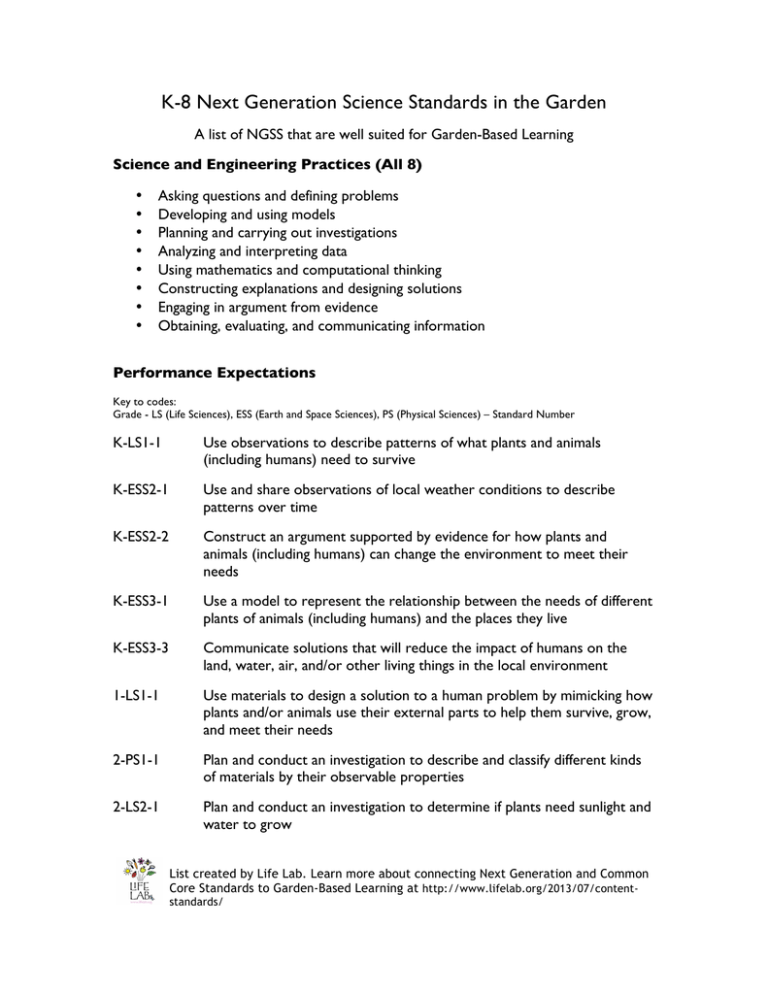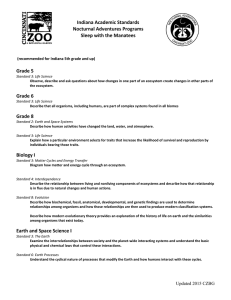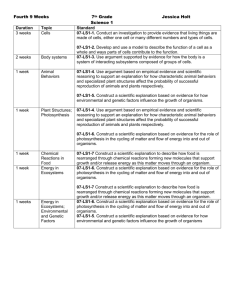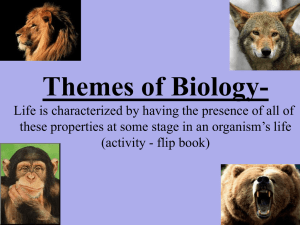K-8 Next Generation Science Standards in the Garden
advertisement

K-8 Next Generation Science Standards in the Garden A list of NGSS that are well suited for Garden-Based Learning Science and Engineering Practices (All 8) • • • • • • • • Asking questions and defining problems Developing and using models Planning and carrying out investigations Analyzing and interpreting data Using mathematics and computational thinking Constructing explanations and designing solutions Engaging in argument from evidence Obtaining, evaluating, and communicating information Performance Expectations Key to codes: Grade - LS (Life Sciences), ESS (Earth and Space Sciences), PS (Physical Sciences) – Standard Number K-LS1-1 Use observations to describe patterns of what plants and animals (including humans) need to survive K-ESS2-1 Use and share observations of local weather conditions to describe patterns over time K-ESS2-2 Construct an argument supported by evidence for how plants and animals (including humans) can change the environment to meet their needs K-ESS3-1 Use a model to represent the relationship between the needs of different plants of animals (including humans) and the places they live K-ESS3-3 Communicate solutions that will reduce the impact of humans on the land, water, air, and/or other living things in the local environment 1-LS1-1 Use materials to design a solution to a human problem by mimicking how plants and/or animals use their external parts to help them survive, grow, and meet their needs 2-PS1-1 Plan and conduct an investigation to describe and classify different kinds of materials by their observable properties 2-LS2-1 Plan and conduct an investigation to determine if plants need sunlight and water to grow List created by Life Lab. Learn more about connecting Next Generation and Common Core Standards to Garden-Based Learning at http://www.lifelab.org/2013/07/content- standards/ 2-LS2-2 Develop a simple model that mimics the function of an animal in dispersing seeds or pollinating plants 2-LS4-1 Make observations of plants and animals to compare the diversity of life in different habitats 2-ESS2-1 Compare multiple solutions designed to slow or prevent wind or water from changing the shape of the land 3-LS1-1 Develop models to describe that organisms have unique and diverse life cycles but all have in common birth, growth, reproduction, and death 3-LS3-1 Analyze and interpret data provide evidence that plants and animals have traits inherited from parents and that variation of these traits exists in a group of similar organisms 3-LS3-2 Use evidence to support the explanation that traits can be influenced by the environment 3-LS4-2 Use evidence to construct an explanation for how the variations in characteristics among individuals of the same species may provide advantages in surviving, finding mates, and reproducing. 3-LS4-3 Construct an argument with evidence that in a particular habitat some organisms can survive well, some survive less well, and some cannot survive at all 4-LS1-1 Construct an argument that plants and animals have internal and external structures that function to support survival, growth, behavior, and reproduction 5-PS3-1 Use models to describe that energy in animals’ food (used for body repair, growth, motion, and to maintain body warmth) was once energy from the sun 5-LS1-1 Support and argument that plants get the materials they need for growth chiefly from air and water 5-LS2-1 Develop a model to describe the movement of matter among plants, animals, decomposers, and the environment 5-ESS3-1 Obtain and combine information about ways individual communities use science ideas to protect the Earth’s resources and environment MS-PS1-3 Gather and make sense of information to describe that synthetic materials come from natural resources and impact society List created by Life Lab. Learn more about connecting Next Generation and Common Core Standards to Garden-Based Learning at http://www.lifelab.org/2013/07/content- standards/ MS-PS3-3 Apply scientific principals to design, construct, and test a device that either minimizes or maximizes thermal energy transfer MS-LS1-4 Use argument based on empirical evidence and scientific reasoning to support an explanation for how characteristic animal behaviors and specialized plant structures affect the probability of successful reproduction of animals and plants respectively MS-LS1-5 Construct a scientific explanation based on evidence for how environmental and genetic factors influence the growth of organisms MS-LS1-6 Construct a scientific explanation based on evidence for the role of photosynthesis in the cycling of matter and flow of energy into and out of organisms MS-LS1-7 Develop a model to describe how food is rearranged through chemical reactions forming new molecules that support growth and/or release energy as this matter moves through an organism MS-LS2-1 Analyze and interpret data to provide evidence for the effects of resource availability on organisms and populations of organisms in an ecosystem MS-LS2-2 Construct an explanation that predicts patterns of interactions among organisms across multiple ecosystems MS-LS2-3 Develop a model to describe the cycling of matter and flow of energy among living and nonliving parts of an ecosystem MS-LS2-4 Construct an argument supported by empirical evidence that changes to physical or biological components of an ecosystem affect populations MS-LS2-5 Evaluate competing design solutions for maintaining biodiversity and ecosystem services MS-LS3-2 Develop and use a model to describe why asexual reproduction results in offspring with identical genetic information and sexual reproduction results in offspring with genetic variation MS-LS4-5 Gather and synthesize information about the technologies that have changed the way humans influence the inheritance of desired traits in organisms MS-ESS2-1 Develop a model to describe the cycling of Earth’s materials and the flow of energy that drives this process List created by Life Lab. Learn more about connecting Next Generation and Common Core Standards to Garden-Based Learning at http://www.lifelab.org/2013/07/content- standards/ MS-ESS2-4 Develop a model to describe the cycling of water through Earth’s systems driven by energy from the sun and the force of gravity MS-ESS3-3 Apply scientific principles to design a method for monitoring and minimizing a human impact on the environment List created by Life Lab. Learn more about connecting Next Generation and Common Core Standards to Garden-Based Learning at http://www.lifelab.org/2013/07/content- standards/




